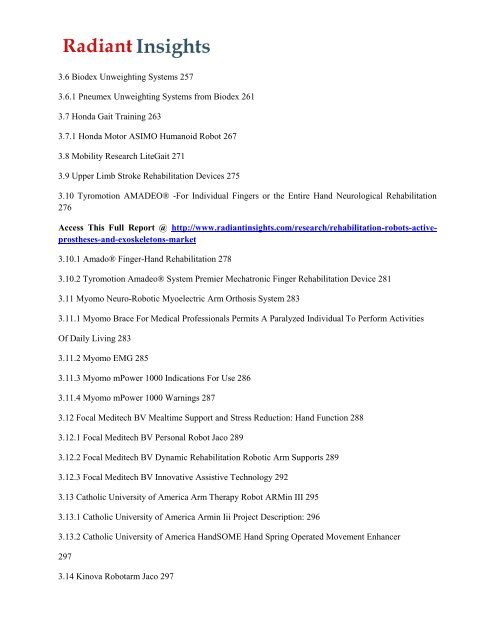Rehabilitation Robots Market Share, Size, Growth, Trend and Forecasts Report 2015 to 2021: Radiant Insights, Inc
WinterGreen Research announces that it has published a new study Rehabilitation Robots: Market Shares, Strategy, and Forecasts, Worldwide, 2014 to 2020. The 2015 study has 659 pages, 266 tables and figures. Worldwide markets are poised to achieve significant growth as the rehabilitation robots, active prostheses, and exoskeletons are used inside rehabilitation treatment centers and sports facilities providing rehabilitation for all patients with injuries or physical dysfunction. Access This Full Report @ http://www.radiantinsights.com/research/rehabilitation-robots-active-prostheses-and-exoskeletons-market Relearning of lost functions in a patient depends on stimulation of desire to conquer the disability. The rehabilitation robots can show patients progress and keep the progress occurring, encouraging patients to work on getting healthier. Independent functioning of patients depends on intensity of treatment, task-specific exercises, active initiation of movements and motivation and feedback. Rehabilitation robots can assist with these tasks in multiple ways. Creating a gaming aspect to the rehabilitation process has brought a significant improvement in systems. As patients get stronger and more coordinated, a therapist can program the robot to let them bear more weight and move more freely in different directions, walking, kicking a ball, or even lunging to the side to catch one. The robot can follow the patient’s lead as effortlessly as a ballroom dancer, its presence nearly undetectable until it senses the patient starting to drop and quickly stops a fall. In the later stages of physical therapy, the robot can nudge patients off balance to help them learn to recover.
WinterGreen Research announces that it has published a new study Rehabilitation Robots: Market Shares, Strategy, and Forecasts, Worldwide, 2014 to 2020. The 2015 study has 659 pages, 266 tables and figures. Worldwide markets are poised to achieve significant growth as the rehabilitation robots, active prostheses, and exoskeletons are used inside rehabilitation treatment centers and sports facilities providing rehabilitation for all patients with injuries or physical dysfunction.
Access This Full Report @ http://www.radiantinsights.com/research/rehabilitation-robots-active-prostheses-and-exoskeletons-market
Relearning of lost functions in a patient depends on stimulation of desire to conquer the disability. The rehabilitation robots can show patients progress and keep the progress occurring, encouraging patients to work on getting healthier. Independent functioning of patients depends on intensity of treatment, task-specific exercises, active initiation of movements and motivation and feedback. Rehabilitation robots can assist with these tasks in multiple ways. Creating a gaming aspect to the rehabilitation process has brought a significant improvement in systems.
As patients get stronger and more coordinated, a therapist can program the robot to let them bear more weight and move more freely in different directions, walking, kicking a ball, or even lunging to the side to catch one. The robot can follow the patient’s lead as effortlessly as a ballroom dancer, its presence nearly undetectable until it senses the patient starting to drop and quickly stops a fall. In the later stages of physical therapy, the robot can nudge patients off balance to help them learn to recover.
Create successful ePaper yourself
Turn your PDF publications into a flip-book with our unique Google optimized e-Paper software.
3.6 Biodex Unweighting Systems 257<br />
3.6.1 Pneumex Unweighting Systems from Biodex 261<br />
3.7 Honda Gait Training 263<br />
3.7.1 Honda Mo<strong>to</strong>r ASIMO Humanoid Robot 267<br />
3.8 Mobility Research LiteGait 271<br />
3.9 Upper Limb Stroke <strong>Rehabilitation</strong> Devices 275<br />
3.10 Tyromotion AMADEO® -For Individual Fingers or the Entire H<strong>and</strong> Neurological <strong>Rehabilitation</strong><br />
276<br />
Access This Full <strong>Report</strong> @ http://www.radiantinsights.com/research/rehabilitation-robots-activeprostheses-<strong>and</strong>-exoskele<strong>to</strong>ns-market<br />
3.10.1 Amado® Finger-H<strong>and</strong> <strong>Rehabilitation</strong> 278<br />
3.10.2 Tyromotion Amadeo® System Premier Mechatronic Finger <strong>Rehabilitation</strong> Device 281<br />
3.11 Myomo Neuro-Robotic Myoelectric Arm Orthosis System 283<br />
3.11.1 Myomo Brace For Medical Professionals Permits A Paralyzed Individual To Perform Activities<br />
Of Daily Living 283<br />
3.11.2 Myomo EMG 285<br />
3.11.3 Myomo mPower 1000 Indications For Use 286<br />
3.11.4 Myomo mPower 1000 Warnings 287<br />
3.12 Focal Meditech BV Mealtime Support <strong>and</strong> Stress Reduction: H<strong>and</strong> Function 288<br />
3.12.1 Focal Meditech BV Personal Robot Jaco 289<br />
3.12.2 Focal Meditech BV Dynamic <strong>Rehabilitation</strong> Robotic Arm Supports 289<br />
3.12.3 Focal Meditech BV Innovative Assistive Technology 292<br />
3.13 Catholic University of America Arm Therapy Robot ARMin III 295<br />
3.13.1 Catholic University of America Armin Iii Project Description: 296<br />
3.13.2 Catholic University of America H<strong>and</strong>SOME H<strong>and</strong> Spring Operated Movement Enhancer<br />
297<br />
3.14 Kinova Robotarm Jaco 297


















